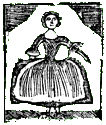 Since I’ve bearded other comics for showing eighteenth-century British-Americans with facial hair, I have to note that several men in Road to Revolution! could use a shave as well.
Since I’ve bearded other comics for showing eighteenth-century British-Americans with facial hair, I have to note that several men in Road to Revolution! could use a shave as well.There are a few hirsute farmers and laborers (like the frontiersman at right), and mustachioed army officers (Hessians wore moustaches, but not British gentlemen). In addition, as you can see, some men appear in clothing more suitable to the next century.
I wrote earlier about how creators Stan Mack and Susan Champlin came to Boston while researching the book to scout out locations like Old North Church and Longfellow National Historic Site. Alas, it’s not so easy to find eighteenth-century people walking around.
We can study paintings, prints, and other period artwork, bearing in mind that expensive portraits show the elite as they wished to be seen, and cartoons exaggerated traits. Would following those models result in every gentleman looking like a clean-shaven white man wearing a white wig, suit, waistcoat, and breeches? Probably so, since in formal portraits every gentleman was a clean-shaven white man wearing a white wig, suit, waistcoat, and breeches. Craftsmen and yeoman farmers tended to dress in a cheaper, sturdier version of the same styles.
Such visual similarity makes it harder to tell a comics story. First in Space is another historically-based graphic novel, about the chimpanzees used in the early U.S. space program. Their keepers are all burly young Air Force men, with crew cuts and T-shirts, and I had real trouble telling those characters apart. So I can understand Mack’s desire for visual variety.
 Another compromise Road to Revolution! makes for the sake of storytelling is modern idioms. Penny not only behaves like a modern girl—even objecting to being called “proper”—but she speaks like one: “You’re not the boss of me!” Her sarcastic “Hilarious” above comes in response to Nick’s boasting at left, which itself is probably more bold than a 1775 teenager would be.
Another compromise Road to Revolution! makes for the sake of storytelling is modern idioms. Penny not only behaves like a modern girl—even objecting to being called “proper”—but she speaks like one: “You’re not the boss of me!” Her sarcastic “Hilarious” above comes in response to Nick’s boasting at left, which itself is probably more bold than a 1775 teenager would be.But of course young readers will have an easier time understanding this familiar way of speaking, and thus have an easier time being entertained while absorbing a bit of history.
Mack’s drawing style, which School Library Journal characterized as both “whimsical illustrations” and “cartoonish scrawls,” is therefore quite appropriate for this book. The story doesn’t pretend to be history; that’s what its endnotes, maps, and encouragement to read more are for. It’s historical fiction, with a lot of adventure and humor. The drawings, informal but full of character, remind us that this is a story.
When I spoke to Mack at the Paul Revere House last weekend, he mentioned Tintin as one of his models for this book, and that sure made sense. The mix of danger and slapstick, the clear good guys and bad guys, the plucky young hero (and heroine), the silent comedic activity going on in the background—all fine lessons from Hergé.








